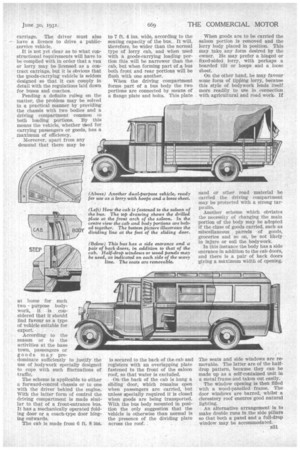How TO DESIGN A
Page 48

Page 49

If you've noticed an error in this article please click here to report it so we can fix it.
DUAL PURPOSE VEHICLE
THERE are occasions when it is desirable to use a lorry as a passenger vehicle, such as when employees are traveling from a factory to a sports ground. Sometimes they are carried free, whilst in other instances a nominal fare is charged so that incidental expenses may be covered.
It is proposed that the regulations of the Road Traffic Act shall not apply if the passengers be carried free, inorder that the activities of Boy Scouts, village sportsmen and others shall not be hampered, and to regularize the matter an amending Bill is to he passed.
But if the passengers pay a fare the lorry owner must apply for a certificate of fitness and a publicservice vehicle licence, each casting n, which, when granted, -allow the vehicle to be run as a contract
carriage. The driver must also have a licence to drive a publicservice vehicle.
It is not yet clear as to what constructional requirements will have to be complied with in order that a van or lorry may be licensed as a contract carriage, but it is obvious that the goods-carrying vehicle is seldom designed so that it can comply in detail with the regulations laid down for buses and coaches.
Pending a definite ruling on the matter, the problem may be solved in a practical manner by providing the chassis with two bodies and a driving compartment common both loading portions. By this means the vehicle, whether trued for carrying passengers or goods, has a maximum of efficiency.
Moreover, apart from any demand that there may be at home for such two purpose bodywork, it is considered that it should find favour as a type of vehicle suitable for export.
According to the season or to the activities at the base town, passengers or goods may predominate sufficiently to justify the use of bodywork specially designed to cope with such fluctuations of traffic.
The scheme is applicable to either a forward-control chassis or to one with the driver behind the engine. With the latter form of control the driving compartment is made similar to that of a front-entrance bus. It has a mechanically operated folding door or a coach-type door hinging outwards.
The cab is made from 6 ft. 8 to 7 ft. 4 ins. wide, according to the seating capacity of the bus.. It will, therefore, be wider than the normal type of lorry cab, and when used with a goods-carrying loadingportion this will be narrower than the cab, but when forming part of .a bus both front and rear portions will be flush with one another.
When the driving compartment forms part of a bus body the two portions are connected by means of a flange plate and bolts. This plate is secured to the back of the cab and registers with an overlapping plate fastened to the front of the saloon roof, so that water is excluded.
On the back of the cab is hung a sliding door, which remains open when passengers are carried, but unless specially required it is closed when goods are being transported. With the bus body mounted in position the only suggestion that the vehicle is otherwise than normal is the presence of the dividing plate across the roof. When goods are to be carried the saloon portion is removed and the lorry body placed in position. This may take any form desired by the owner. He may prefer a hinged or fixed-sided lorry, with perhaps a boarded tilt or hoops and a loose sheet.
On the other hand, he may favour' sothe form of tipPing lorry, because this style of bodywork lends itself more readily to use in connection, with agricultural and road work. If
sand or other road material be carried the driving compartment may be protected with a strong tarpaulin.
Another scheme which obviates the necessity of changing the main portion of the body may be adopted if the class of goods carried, such as miscellaneous parcels of goods, groceries and so on, be not likely to injure or soil the bodywork.
In this instance the body has a side entrance in addition to the cab doors, and there is a pair of back doors giving a maximum width of opening.
The seats and side windows are removable. The latter are of the halfdrop pattern, because they can be made up as a self-contained unit in a metal frame and taken out easily.
The window opening is then filled with a wood-panelled frame. The door windows are barred, whilst a clerestory roof ensures good natural lighting. An alternative arrangement is to make double runs in the side pillars so that both a panel and a full-drop window may be accommodated.




































































































